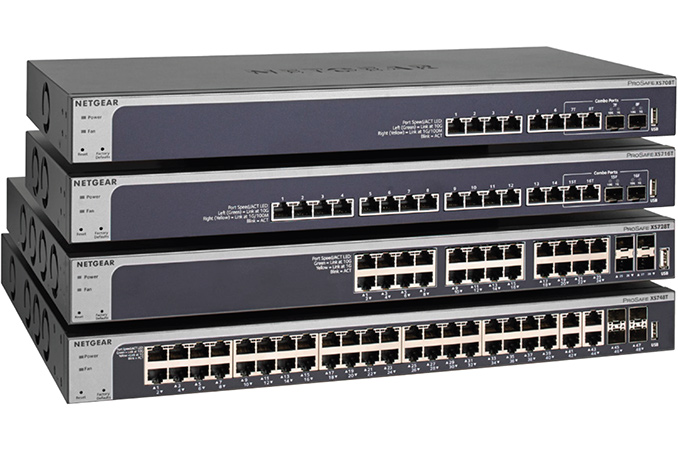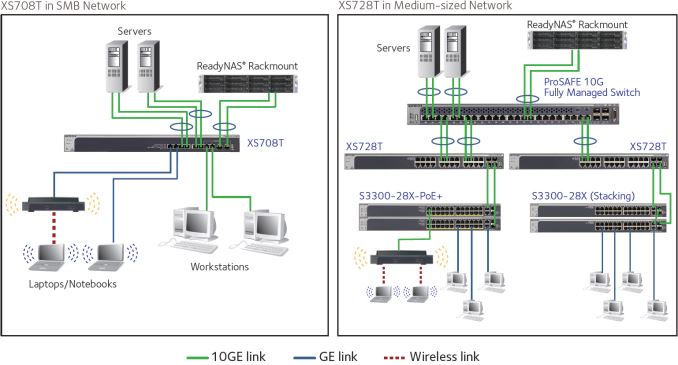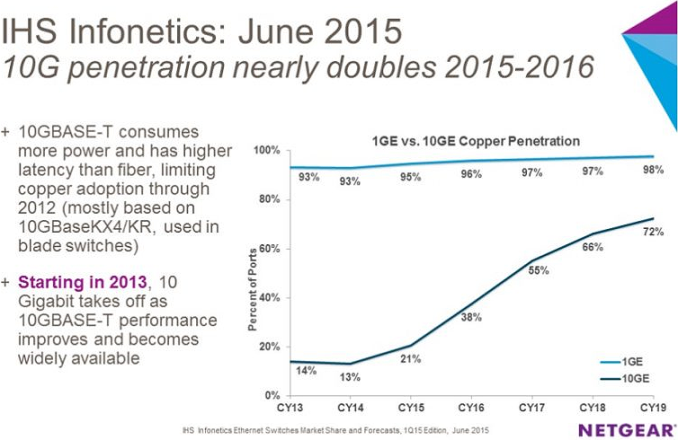Netgear Introduces Second-Gen ProSAFE 10GBase-T Switches for SMBs
by Anton Shilov on May 17, 2016 8:30 AM EST- Posted in
- Networking
- NetGear
- 10GBase-T

NetGear has introduced four new ProSAFE 10 GbE switches for small and medium businesses, upgrading their first generation of XS708E and XS712T parts. The new switches support both copper (10GBase-T) and fiber links, IPv6 management as well as Layer 2+/Layer 3 Lite features. NetGear claims that the new switches are significantly more cost-efficient than previous-generation 10 GbE products.
Internet speeds and file sizes increased orders of magnitude in the last ten years and for many offices (and prosumers), Gigabit Ethernet or basic teaming might no longer be enough. As a result, many businesses and individuals these days are evaluating migration to 10 Gigabit Ethernet, which of course has immediate high performance, but is more expensive on per-port basis than traditional GbE (as well as power consumption when looking for RJ45 compatibility). Fortunately, in the recent quarters, a number of companies have started to offer moderately priced 10 GbE switches supporting both copper and fiber links that can enable a more cost-efficient transition to 10 Gigabit networks.
The four new ProSAFE 10 GbE Smart Managed Switches from NetGear are the 8-port XS708T, the 16-port XS716T, the 24-port XS728T and the 44-port XS748T. The 8- and 16-port switches are based on single-core ARM Cortex-A9 600 MHz processor, whereas the more powerful 24- and 44-port models feature dual-core ARM Cortex-A9 800 MHz processor.
| NetGear ProSAFE 10 GbE Smart Managed Switches | ||||||
| XS708T | XS716T | XS728T | XS748T | |||
| 10GBase-T RJ-45 | 8 | 16 | 24 | 44 | ||
| SFP Ports | 2 shared | 4 dedicated | ||||
| CPU | Single-core ARM Cortex-A9 600 MHz | Dual-core ARM Cortex-A9 800 MHz | ||||
| RAM | 512 MB | |||||
| Non-Volatile Memory | 8MB SPI + 256 NAND | |||||
| Packet Buffer | 2 MB | 3 MB | ||||
| ACLs | 100 shared | 164 shared | ||||
| MAC Address Table RP/NDP Table VLANs |
16K MAC 738 ARP/NDP 256 VLANs |
16K MAC 1K ARP/NDP 512 VLANs |
||||
| Fabric Bandwidth | 160 Gbps | 320 Gbps | 560 Gbps | 960 Gbps | ||
| Rated Latency | 10GBASE-T: <3.012 μs SFP+: <2.466 μs |
10GBASE-T: <2.624 μs SFP+: <2.128 μs |
10GBASE-T: <11.649 μs SFP+: <2.619 μs |
10GBASE-T: <3.674 μs SFP+: <3.693 μs |
||
| Static Routes (IPv4 & IPv6) |
IPv4: 32 IPv6: 32 |
IPv4: 64 IPv6: 64 |
||||
| Multicast IGMP Group |
512 | |||||
| USB Port | One port for firmware and config access | |||||
| Rated Power Consumption | 49.5 W | 96.0 W | 134.9 W | 262.8 W | ||
| Price | $1558 | $2623 | unknown | $8198 | ||
The switches support modern VLAN features, such as protocol-based VLAN, MAC-based VLAN and 802.1x Guest VLAN; advanced QoS with L2/L3/L4 awareness and eight priority queues including Q-in-Q; dynamic VLAN assignment; IPv4 and IPv6 routing; IPv6 for management, QoS and ACL and so on. The devices come in rackmount form-factors and consume from 49.5 W to 262.8 W of power.
According to a survey of over 550 IT decision-makers in the U.S, U.K., and Germany ordered by NetGear and conducted by Palmer Research, approximately 33% of sub-500-employee businesses today already have 10 GbE switching to connect to modern 10 GbE servers and NAS. Meanwhile, a lot of those who currently do not use 10 GbE are considering to deploy it and plan to do so in the coming quarters. The survey says that by the end of 2017, 75% of the aforementioned organizations will have deployed a 10 GbE backbone by the end of 2017. Analysts from IHS (according to data provided by NetGear) seem to agree with the results of the survey and believe that adoption of 10 GbE is increasing rapidly these days.
Pricing of these switches are a lot higher than standard gigabit ethernet switches as 10GbE networks typically require the advanced management protocols for businesses and enterprise, whereas home users might be happy with a simple pass-through device. Because of the market, and the management requirements, we are still looking at above $150 per port for 10GbE. The NetGear ProSAFE XS708T and XS716T are available now for $1558 ($194.75 per port) and $2623 ($164 per port), respectively. The top-of-the-range XS748T will ship in July for $8198 ($186 per port). Pricing and availability of the XS728T were not touched upon by NetGear. By comparison, the popular first generation 8-port XS708E switch is retailing for $850 ($106.25 per port) at this point in its life cycle.
Sources: NetGear, ServeTheHome.












46 Comments
View All Comments
Daniel Egger - Tuesday, May 17, 2016 - link
> The beauty of 10G over copper is that if your wire length is less than 30M you can probably already do it on Cat5e without a cable upgrade.No, that's almost impossible. A properly installed Cat.6 cabling might /just/ work... Cat.5 is only certified for 100MHz operation, Cat.6 for 250MHz (and hence might work for shorter distances), Cat.6a for 500MHz. Proper installation is a hard requirement, so either a point-to-point connection with a single ready-made cable or a properly done fixed installation is a hard requirement; if you don't have a measurement protocol for your installation chances are you do not apply for 10GBase-T.
Duncan Macdonald - Wednesday, May 18, 2016 - link
Cat5e may not be certified for 10G - however for short distances it will work. (Just like an incorrect type of coax would work for a short thin Ethernet connection back in the early days of networking.)According to Intel's specs for their current 10Gbase-T NICs:
- For cable distances up to about 55m Cat6 is acceptable (YMMV)
- For cable distances up to about 20m Cat5e is acceptable (YMMV)
- For cable distances up to about 3m, plain old Cat5 is acceptable (YMMV)
(Info copied from https://hardforum.com/threads/cat-5e-vs-cat-6.1600... )
coastinthefog - Thursday, May 19, 2016 - link
I have the 1st gen 8 port version of one of these. It's running at 10G over cat5e without a problem. Relatively short run probably less than 50 feet.cm2187 - Tuesday, May 17, 2016 - link
And with SSDs getting cheaper, they will make their way to NAS pretty quickly and then we actually are going to use 10GbE regularly.I am not bullish on 100GbE though. That would be more data than a CPU can pump in and out and those aren't really going any faster. I don't see how we could use that. Not absurd to assume 10GbE is the last deployment at least for end points (I am not talking about inter router links).
bcronce - Tuesday, May 17, 2016 - link
Every so often I need to move a 60GiB file. Waiting 1min for a 10GB/s server is jarring to my work flow, but waiting 10 minutes will interrupt my work flow.SirNuke - Wednesday, May 18, 2016 - link
There is *literally* nothing productive that you can do for 10 minutes every once in a while? That sounds more like a time-management issue than a technology issue.bcronce - Tuesday, May 17, 2016 - link
Once chipsets reach 22nm, we should start to see 10Gb on laptops. Intel went from 32nm to 28nm on their NICs and went from 10Gb to 40Gb, reduced the price 30%, and reduced power consumption 50%. That was only a 12% reduction in size.Intel said that 22nm we should see 10Gb NICs in low end laptops, and 14nm we should see 40Gb. Major players are still too busy cranking out $500 CPUs, not $1 integrated NICs. Once 10nm makes it, we should see the 22nm manufacturing free up enough for low end parts to be made.
Death666Angel - Tuesday, May 17, 2016 - link
"That was only a 12% reduction in size."Isn't it more like a 23% reduction, since it is an area (32nm in one direction and the other, vs 28nm in one direction and the other) and not a line? :)
bcronce - Tuesday, May 17, 2016 - link
Correct, but I didn't want to dive into all of that, but it is a common mistake for many to make when talking about chip sizes.damianrobertjones - Tuesday, May 17, 2016 - link
I do not eat data.